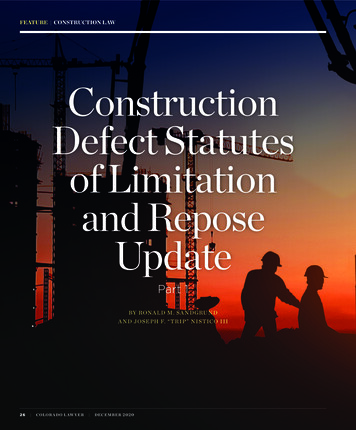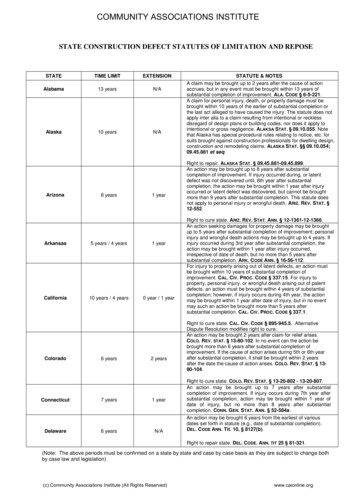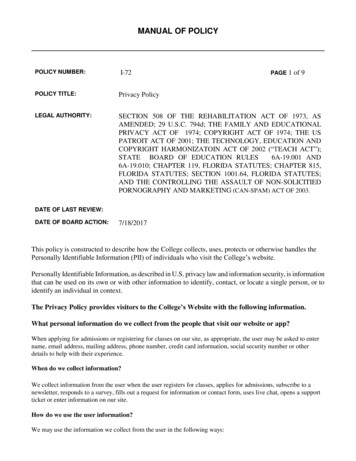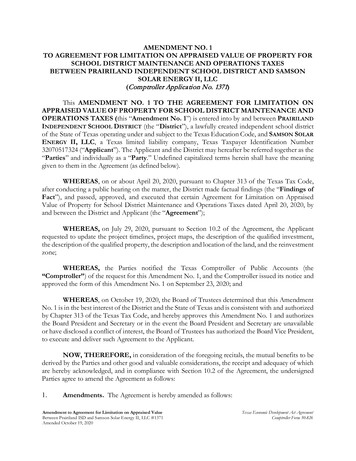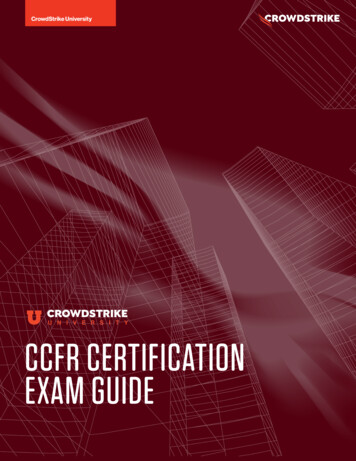
Transcription
We are a full-service Civil Litigation Defense firm serving Western/Central Pennsylvania and West VirginiaSeptember 2016The Gulf Tower14th Floor707 Grant StreetPittsburgh, PA 15219Telephone: 412-258-2255Fax: 412-263-5632www.walshlegal.netWalsh, Barnes, Collis & Zumpella,P.C. represents insurance carriers,their insureds, and corporations inactions encompassing the entire civillitigation spectrum. We provide defenseof wrongful death and personal injuryclaims in addition to property lossesresulting from: Automobile andTractor Trailer Accidents Catastrophic Fire Losses Construction Accidents Employment Practices Liability Executive Liability Insurance Coverage Premises Liability Product Liability Professional LiabilityIN THIS ISSUE:Statutes of Limitation and Reposein Construction Defect Cases. Page 1Workers’ Compensation Immunityis Broad, But . Page 3U.S. Supreme Court Expands Statute ofLimitation Periods in FederalEmployment Case Law. Page 4Threshold Issues in Public EmployeeFirst Amendment Retaliation Claims . Page 5Trends in Attendance at IMEExaminations by Third Parties . Page 6Announcements/Results . Page 7Top Ten Legal Movies . Page 8Statutes of Limitation and Reposein Construction Defect CasesTheaffirmativedefensesof the statute of limitations andthe statute of repose are two (2)powerful defenses a defendantin a construction defect case mayassert. Although the successfulassertion of both of these defensesmay result in an early dismissal ofa lawsuit, these defenses are quitedifferent in both theory and practicalapplication.Generally, a statute of limitationsets a maximum time period duringwhich a certain action can be broughtor a certain right enforced. A statuteof limitation is an affirmative defensethat must be pleaded in a responsivepleadingundertheheading“New Matter.”Pa.R.C.P. 1030.Pennsylvania statutory law providesfor numerous statutes of limitations,which are generally codified in Title142 of the Pennsylvania ConsolidatedStatutes.A statute of repose is a statutebarring any suit that is brought aftera specified time since the defendantacted, even if this period endsbefore the plaintiff has suffered aresulting injury. A statute of reposebegins to run upon the completionof certain conduct by a party. Graverv. Foster Wheeler Corp., 96 A.3d383 (Pa.Super. 2014). Becausea statute of repose focuses solelyon a defendant’s actions, it maypotentially bar a plaintiff’s suit beforethe cause of action arises. Likea statute of limitation, a statute ofrepose is as an affirmative defense.Although statutes of limitationand statutes of repose are similarin that they are affirmative defenses(Continued on page 2)
Statutes of Limitation and Repose in Construction Defect Cases (Continued)This statute of repose provides an exception:that establish the time in which a plaintiff must bring acause of action, the similarities end there. Statutes oflimitation are a form of procedural law that bar recoveryon an otherwise viable cause of action. On the otherhand, statutes of repose operate as substantive lawby extinguishing a cause of action outright. Graver,supra. Although a statute of limitation may be tolledby a plaintiff’s failure to discover the legal injury, astatute of repose generally will not be tolled under anycircumstances, including a plaintiff’s failure to discoveran injury.Moreover, unlike a statute of limitation, a statute ofrepose is not waived if a litigant fails to plead it as anaffirmative defense as it is a non-waivable legislativeenactment. Mitchell v. United Elevator Co., Inc., 434A.2d 1243, 1249 (Pa.Super. 1981). Therefore, it maybe properly raised at any point in the litigation, includingthrough a motion for non-suit, directed verdict, orjudgment notwithstanding the verdict. Id. (citationsomitted).(1) If an injury or wrongful death shall occur morethan 10 and within 12 years after completion ofthe improvement, a civil action or proceedingwithin the scope of subsection (a) may becommenced within the time otherwise limitedby this subchapter, but not later than 14years after completion of construction of suchimprovement.42 Pa.C.S.A. §5536(b)(1). Thus, although it iscommonly regarded that construction claims are barred ifcommenced later than 12 years, the foregoing exceptionpermits a claim to be brought within 14 years after thecompletion of the construction of the improvement.There are four (4) common statutes of limitationapplicable to construction defect cases. First andmost commonly, is the four (4) year limitation periodfor contract-related actions, including warranty claims,as most construction cases arise out of a contractualundertaking between two or more parties. 42 Pa.C.S.§5525. This statute of limitation also applies to claimsfor implied warranty of reasonable workmanship,quasi-contract, and quantum meruit.Second, a two (2) year limitation applies to anyaction based upon “negligent, intentional or otherwisetortious conduct,” including deceit or fraud. 42 Pa.C.S.§5524. In addition to the garden variety action fornegligent construction, this limitation period governs anaction by a contractor for negligent misrepresentationagainst a design professional for errors or omissionsin a project design. Section 552 of the Restatement(Second) of Torts; Bilt-Rite Contractors, Inc. v. TheArchitectural Studio, 866 A.2d 270 (Pa. 2005).Third, there is a six (6) year statute of limitationthat applies to actions not specifically addressed byany other limitation period. 42 Pa.C.S. §5527. Themost common claim is for violations of Pennsylvania’sUnfair Trade Practice and Consumer Protection Law arecommonly asserted in construction defect cases basedupon deceptive conduct or misrepresentations relativeto the work to be performed or the quality of the work.Finally, a one (1) year limitation period governsactions based upon a payment or performanceconstruction bond. 42 Pa.C.S. §5523.Statutes of repose and statutes of limitations canbe effective affirmative defenses in construction defectlawsuits. Each should be identified early in a lawsuitto ensure the defense is asserted the answer andevidence to support a motion for summary judgmentis properly developed through written discovery andwitness depositions.Common Statutes of Repose and Limitations inConstruction Defect CasesOne such statute of repose relatesimprovements to real property, which provides:to§5536. Construction Projects(a) General Rule--except as provided in subsection(b), a civil action or proceeding brought against anyperson lawfully performing or furnishing the design,planning, supervision, or observation of construction,or construction of any improvement to real propertymust be commenced within 12 years after completionof construction of such improvement to recoverdamages for:(1) Any deficiency in the design, planning,supervision or observation of construction orconstruction of the improvement.(2) Injury to property, real or personal, arising outof any such deficiency.(3) Injury to the person or for wrongful death arisingout of any such deficiency.(4) Contribution or indemnity for damagessustained on account of any injury mentionedin paragraph (2) or (3)42 Pa.C.S.A. §5536(a) (emphasis added). It isimportant to note, the period to commence a claim iscalculated not from the time of the defendant’s conductnecessarily, but rather from the completion of theconstruction of the improvement.2
Workers’ Compensation Immunity is Broad, But The workers’ compensation immunity of the arranged for evaluation at a psychiatric center,employer is broad, and that immunity extends to the which led to the employee being treated with electroworkers’ compensation insurance carrier and third party convulsive therapy (ECT). The ECT exacerbated theadministrator (“TPA”). But the immunity is not absolute, employee’s underlying post-traumatic stress disorderand in some circumstances the carrier or TPA can be (caused initially by service during the Vietnam war), andsued civilly for claims adjusting missteps. In a recent he eventually learned the treatment was inappropriatedecision (Charlton v. PMA Insurance Group, 2015 WL for his conditions. He filed a civil suit against the nurse,6870724 (Pa. Super. Ct. 2015), appeal denied, the physicians and psychiatric clinic which oversaw theA.3d (Pa. 2016)), the Superior Court allowed such treatment, and Wausau. As to Wausau and the nurse,a lawsuit against a carrier and claims representative. the employee claimed they were negligent in d, and thereforemedical care. The SuperiorWhere a claim is not “ultimately”lacks precedential value.Court held the civil suitbased on compensation injury,However, the Charltoncould proceed, determiningdecision tracks an earlierthe injury claimed did notimmunity is not available.opinion to the same effect.arise from the work-relatedTaras v. Wausau Ins. Cos.,injury.602 A.2d 882 (Pa. Super. Ct. 1992). The Charlton caseIn Charlton, the employee was injured at work inis a worthy reminder of the limits of immunity.1986 and experienced both physical and psychologicalIn Taras, the employee was injured in a work- injuries. The carrier paid for the employee’s medicalrelated auto accident. He had physical injuries, as well and psychiatric treatment. The employee revealed toas resulting depression and anxiety. Wausau insured the psychiatrist treating him for his work-related injuriesthe employer and commenced payment of benefits. that he had been a victim of sexual abuse as a child.Wausau used a registered nurse to analyze and The psychiatrist referred the employee to anothermonitor the employee’s medical care. According to the therapist for treatment of this non-work-related issue.employee, the nurse case manager told him he would Several years later, the carrier’s claims representativehave to undergo treatment as determined necessary reviewed the notes of the psychiatrist treating theby Wausau to continue receiving benefits. The nurse work-related conditions, and noted the referenceto the employee’s past history of being sexuallyabused. The claims representative then contactedthe employee by phone and advised him the carrierPartner Contact Informationwas “tired of paying for something that happened toyou as a child.” In the same conversation, the claimsPaul J. Walsh III412-263-5237representative demanded the employee settle hispwalsh@walshlegal.networkers’ compensation claim.The employee became agitated and anxious onAdam M. Barneshearingthis commentary from the claims representative.412-261-3268Hebelievedit was a threat to shame him if he did notabarnes@walshlegal.netsettle his workers’ compensation claim. His concernsPamela V. Colliswere not alleviated by a follow-up voicemail message412-263-5238in which the claims representative stated there wouldpcollis@walshlegal.netbe no dissemination or further discussion of theGina M. Zumpellachildhood sexual abuse. The employee filed suit,412-263-5221contending the carrier was liable for negligent inflictiongzumpella@walshlegal.netof emotional distress. The trial court granted judgmenton the pleadings in favor of the carrier and claimsSusan A. Kostkasrepresentative, determining they were immune from412-261-3389skostkas@walshlegal.netsuit. The Superior Court reversed. Relying on Taras,the Superior Court held the cause of action aroseEdward A. Yurconfrom a condition unrelated to the work injury. Where a412-263-5218claim is not “ultimately” based on compensable injury,eyurcon@walshlegal.netimmunity is not available.3
U.S. Supreme Court Expands Statute of Limitation Periodsin Federal Employment Case LawThe U.S. Supreme Court recently expanded thelimitation period for a federal employee’s constructivedischarge claim under Title VII in the case of Green v.Brennan, 136 S. Ct. 1769 (2016). In a 7 to 1 decision,the Green Court held the 45 day clock for a federalemployee’s constructive discharge claim under TitleVII began running only after the employee gave theemployer notice of his resignation.Plaintiff, Marvin Green, was an African Americanman who worked at the Postal Service for 35 years.In 2008, he was serving as the Postmaster forEnglewood, Colorado when he applied for a promotionto the vacant Postmaster position in near-by Boulder.He was not hired for the position, and shortly thereafterhe complained he was denied the promotion becauseof his race. Following his complaint, his relationswith his supervisors “crumbled”. Id. at 1774. He wasaccused of intentionally delaying the mail, which isa criminal offense. Id. Ultimately, an agreement wassigned between the Postal Service and Green wherebythe Postal Service promised not to pursue criminalcharges in exchange for Green’s promise to leave hispost in Englewood. Green was also given a choice ofeither retiring effective March 31, 2010 or reporting forduty in Wamsutter, Wyoming – population 451 – at asalary considerably lower than what he earned in hisDenver suburb. Green chose to retire and submittedhis resignation to the Postal Service on February 9,2010 effective, March 31, 2010. Id.Green contacted an Equal Employment Opportunity(EEO) counselor to report an unlawful constructivedischarge on March 22, 2010. This was 41 days aftersubmitting his resignation paperwork to the PostalService, but 96 days after signing the settlementagreement in December 2009. His contention was hissupervisors had threatened criminal charges, and thus,negotiated the resulting agreement in retaliation for hisoriginal Complaint. Id.Green eventually filed suit in the District ofColorado, alleging constructive discharge. The PostalService successfully moved for summary judgment,arguing Green failed to make timely contact with anEEO counselor within 45 days of the “matter allegedto be discriminatory” as required by 29 CFR Section1614.150(a)(1).The Supreme Court noted that, under the standardrule, a “limitations period commences when the plaintiffhas a complete and present cause of action”. However,a cause of action does not become, for limitationspurposes, complete and present until the plaintiff canfile suit and obtain relief. The Court concluded the“matter alleged to be discriminatory” for a constructivedischarge claim to include the date Green resigned.The Court held such a claim accrues only after theemployee resigns. Id. at 1776.Notably, the Court also addressed the issue of whenprecisely a resignation occurs. Since, in an ordinarywrongful discharge claim, the limitations period beginsto run when the employer notifies the employee he isfired, not on the last date of employment, it follows thatfor a constructive discharge claim the limitations periodbegins to run when the employee gives notice of hisresignation, not on the effective date of that resignation.Id. at 1782. The Court remanded the case to the TenthCircuit to determine when in fact Green actually gavenotice since the Postal Service argued the signing ofthe agreement in December 2009 was the resignation,and Green argued he did not resign until February 9,2010, when he submitted the retirement paperwork.The examination of employment law by the land’shighest court continues to provide concerns aboutexpanding plaintiffs’ rights to reach a jury. Strictlyspeaking, the decision in Green applies to federalemployees suing under federal law, but it is speculatedthat its reasoning and decision will likely reach into otheremployment discrimination cases as well. As such,there may be some potential to influence limitationsperiods in the private sector.4
Threshold Issues in Public EmployeeFirst Amendment Retaliation ClaimsCitizen SpeechA public employee’s speech is protected activity,when in making it, the employee 1) spoke as a “citizen”;2) the statement involved a matter of public concern; and3) the government employer did not have “an adequatejustification for treating the employee differently fromany other member of the general public” as a result ofthe statement made. A public employee, does not speak“as a citizen” when the statement is made pursuantto their official duties. Garcetti v. Ceballos, 547 U.S.410 (S.Ct. 2006). Accordingly, Garcetti requires courtsto determine, at the threshold, whether the employeespoke in their capacity as a citizen or as an employee,as the First Amendment does not protect speech madein the course and scope of the public employee’s duties.Moreover, even if the employer engaged in “citizenspeech”, and the subsequent employment actionsconstitute adverse treatment, the employer mustestablish the key speech was “a substantial factor” inany subsequent adverse action. The causation elementfor establishing a retaliation claim considers timing andevidence of ongoing antagonism. Brennan v. Norton,350 F.3d 399 (3rd Cir. 2003). Courts in this jurisdictionhave held the time span of several months is too great.See Wells v. Miller, 2009 WL 2981945 (W.D.Pa. 2009).Insurers of public sector entities frequentlyencounter First Amendment retaliation claims filed byemployees, pursuant to 42 U.S.C. § 1983, allegingthe employee’s right of free speech was inhibitedby some form of retaliatory action on the part of thegovernmental employer.The statute of limitations for a § 1983 action isgoverned by the personal injury tort law of the statewhere the cause of action arose. Stascavage v.Borough of Exeter, WL 65938037 (M.D. Pa. 2012).Consequently, the statute of limitations for § 1983claim’s in Pennsylvania is 2 years. Courts haverepeatedly held the statute of limitations may be raisedin a motion to dismiss when the defense is clearlyapparent on the face of the complaint.To make out a First Amendment retaliation claimthe employee must establish: 1) he/she engagedin protected speech, 2) the employer took adverseaction sufficient to deter a person of ordinary firmnessfrom exercising their First Amendment rights, and 3)the adverse action was prompted by the employee’sprotected speech. See Wilson v. Zielka, 3 Fed. Appx.151 (3d Cir. 2010) citing Mitchell v. Horn, 318 F.3d 523(3d Cir. 2003).The defense of such claims can exact a substantialcost in time, energy and treasure making it essentialthat defense counsel attack the complaint at the earliestpossible time via a motion to dismiss or a motion for amore definitive statement and by asserting the defenseof qualified immunity. Such an aggressive approach isfavored by the Courts.Qualified ImmunityIf the employee’s complaint sufficiently sets fortha cause of action for First Amendment retaliation,defense counsel should attempt to assert the qualifiedimmunity defense, which shields government officialsperforming discretionary functions “from liability in civildamages insofar as their conduct does not violateclearly established statutory constitutional rights whicha reasonable person would have known.” Miller v.Clinton County, 544 F.3d 542 (3rd Cir. 2008). Qualifiedimmunity is “an entitlement not to stand trial or face theother burdens of litigation.” Saucier v. Katz, 533 U.S.194 (S. Ct. 2001). Therefore, any claim of qualifiedimmunity must be resolved at the earliest possiblestage of litigation.Claims for qualified immunity are evaluatedusing a 2 step process. First, the courts must decidewhether the facts, taken in the light most favorable tothe employee, show a constitutional violation. If theemployee fails to make out a constitutional violation, thequalified immunity inquiry is at an end. If evidence of aconstitutional violation has been introduced, courts thendetermine whether the constitutional right was clearlyestablished.Actual SpeechIt is well established there must be actual speechfor an employee to pursue a claim. See Ambrose v.Twp. of Robinson, PA, 303 F.3d 488 (3d Cir. 2002). InAmbrose a police officer sued the township alleginghis suspension was in retaliation for his aid and/or support of a fellow officer’s lawsuit against thetownship. On appeal, following an initial jury verdict infavor of the police officer, the Court of Appeals held1) there was insufficient evidence the officer’s speechwas a motivating factor in his suspension, and 2) theDistrict Court’s “perceived support” theory did notprovide a legal basis for liability. The court explaineda retaliation case can only be sustained if the conductwas constitutionally protected, and, therefore, only ifthere was actually conduct. In Ambrose the court foundthere was no conduct, i.e. speech, so there was noretaliation claim.5
Threshold Issues in Public Employee First Amendment Retaliation Claims (Continued)In Miller, a former county probation office employeealleged she was discharged by the defendant Judge asa result of her writing a letter criticizing her supervisors.Following denial of the Judges’ Motion to Dismiss andMotion for More Definite Statement, an appeal followed.The Third Circuit held the employee had not engagedin protected speech and, therefore, could not establisha retaliation claim because her speech, while touchingon matters of public concern, focused on her privategrievances as an employee and her other remarkswere collateral. As the employee failed to make out aconstitutional violation, the qualified immunity inquiryended, and the Judge was entitled to immunity.of violation of clearly established law, a defendantpleading qualified immunity is entitled to dismissalbefore the commencement of discovery. A complaintfashioned under a simplified notice pleading standardoften fails to provide sufficient factual information forthe defendant to frame a proper qualified immunitydefense. For the same reason, the district court isoften hard pressed to conduct the fact specific qualifiedimmunity analysis at an early stage in the litigation.Consequently, it is possible the Complaint, whilecomplying with the notice pleading standard lacksfactual information necessary to frame the qualifiedimmunity defense. This may compel the defendant toengage in discovery and suffer the burdens of litigation,thereby obviating the protections of qualified immunity.In such situations a motion for a more definitivestatement is the best procedural tool available to obtainthe factual basis underlying the employee’s claim forrelief. The district court will likely avail itself of thisoption before addressing the immunity defense.F.R.C.P. 12 (e)While the Federal Rules of Civil Procedure requireonly notice pleading, resolution of the qualified immunitydefense entails specific inquiry should be made at theearliest possible stage in litigation.The United States Supreme Court stated in Saucierthat unless the employee’s allegations state a claimTrends in Attendance at IME Examinations by Third PartiesThere has been a recent trend of attorneys, thirdparties and even experts attending Independent MedicalExaminations (IMEs) with plaintiffs in Pennsylvania.Under Pa.R.C.P. 4010(a)(4)(i), an individual who willbe examined has the right to have counsel or anotherrepresentative present during examination. While therehas been no definitive ruling from the Pennsylvaniaappellate courts, several cases have held the term“another representative” includes third parties andexperts. In Harding v. Sears, Roebuck & Co., 47 Pa.D. & C. 3d 591 (C.C.P. Wash. Co. 1987), the trial courtheld the plaintiff would be permitted to have her ownchiropractor present at her IME. The trial court notedthere was no specification as to who could attend anIME and as such, a medical expert could attend anexamination.There is no requirement under the Rules thata plaintiff’s counsel give notice that someone willaccompany the plaintiff to an IME. Thus, it is importantto determine up front if a plaintiff will have someoneaccompanying them to an examination to assesswhether defense counsel needs to be present or theexamination needs to be documented by video and/ortranscription. In some cases it may also be necessaryto depose the individual attending the examinationto determine what observations were made duringthe examination, which could be used to impeach anexpert on cross-examination at trial. In Black-Dienes v.Markey, 40 Pa. D. & C. 4th 571 (C.C.P. York Co.) defensecounsel sought to depose a paralegal and nurse froma plaintiff’s counsel’s office who had attended plaintiff’sIME as a representative. Plaintiff’s counsel argued theparalegal was protected under Pa.R.C.P. 4003.5(a)(3)as she would not be called as a witness at trial.The Court in observed Pa.R.C.P. 4003.5(a)(3) doesnot apply to a party’s employee. It noted Pa.R.C.P.4003.5 was designed to prevent an attorney fromengaging an individual to investigate a client’s claimand then designating that person as an expert to avoidotherwise permissible discovery.The Court also noted Pa.R.C.P. 4010(a)(4)(i)made a party’s attorney or representative’s presence amatter of right. The Court held what plaintiff’s paralegaland nurse saw and heard at the IME were not workproduct, but any opinion or evaluation based on thoseobservations was work product pursuant to Pa.R.C.P.4003.3.The Court further held plaintiff’s representativecould be deposed as she might be offered to impeachthe IME doctor as to what occurred at the examination,but the deposition would be strictly limited to factualobservations of the IME.6
Announcements/ResultsAnnouncementsn Pam Collis was elected to the Allegheny CountyAcademy of Trial Attorneys. This is a peer organization,invitation only, limited to 250 trial attorneys in AlleghenyCounty, PA. It is an honor to be nominated as theAcademy is comprised of experienced litigators, bothplaintiff and defense, with a proven trial record. Ourfirm is well represented as Pam joins Paul Walsh andEd Yurcon who are members as well.n Gina Zumpella was appointed to the Claims andLitigation Management Alliance Western PennsylvaniaLeadership Team. The Claims and LitigationManagement Alliance (CLM) is collaborative organizationthat promotes and furthers the highest standards ofclaims and litigation management. CLM’s Members andFellows include risk and litigation managers, insuranceand claims professionals, corporate counsel, outsidecounsel and third party vendors. The CLM sponsorseducational programs, provides resources and fosterscommunication among all in the industry.Resultsn In August 2016, the Superior Court ofPennsylvania affirmed a directed verdict in favor ofour client. In the case at issue, plaintiff had allegedthat our client and a co-defendant were responsible fordamage to his property from an improperly functioningstorm water drainage system. Directed verdict wasgranted in our client’s favor at trial. The co-defendantargued on appeal that evidence existed that theproperty damage sustained to plaintiff’s property wasthe result of actions by our client. Susan Kostkas andMatthew Hronas successfully argued that no evidenceexisted that our client was responsible for the improperfunctioning of a storm water drainage system. TheSuperior Court agreed.recovery against us as our client was joined after theStatute of Limitation lapsed. Upon Motion for SummaryJudgment, the Court found that no evidence existed tohold the original defendant liable for the plaintiff’s tripand fall and that none of the Defendants had a duty towarn the plaintiff of the electrical cord which was openand obvious. After the Motion for Summary Judgmentwas granted, all crossclaims against our client weredismissed as well.n Adam Barnes recently obtained summary judgmentin a declaratory judgment action in Cabell County, WestVirginia on behalf of the insurance carrier client. Thepolicyholder, the general contractor for the constructionof a shopping center, sought coverage for a lawsuitfiled against it by the property owner alleging defectsin the ground preparation of several store locations,which resulted in movement at various locations withinthe plaza and resulting damage to building structuresand other improvements. The property owner seeksmillions of dollars for cost of repairs, lost rent for vacatedtenancies, and reputational damages. The trial courtdeclared the client owed no duty to defend or indemnifythe policyholder based the Contractual Liability exclusionof the CGL and Umbrella policies.n In June 2016, Gina Zumpella obtained adismissal of a personal injury case in WestmorelandCounty, Pennsylvania. Our client was joined as anAdditional Defendant to the lawsuit. The plaintiffalleged that the original defendant was responsiblefor his injuries sustained when he tripped over anelectrical cord in an active work site. Our client, asubcontractor of the original defendant, was joined tothe action. We first successfully argued via PreliminaryObjections that the Plaintiff had no direct right of7
Top Ten Legal Movies10. The Verdict (1982) – A down on his luck alcoholiclawyer takes a medical malpractice case to redeem himself,encountering trials and tribulations in his search for justice.Starring Paul Newman, James Mason and CharlotteRampling and directed by Sidney Lumet, this film wasnominated for five Academy awards.4. And Justice for All (1979) – Arthur Kirkland, a fierycriminal defense attorney in Baltimore, is jailed afterpunching Judge Henry Fleming while arguing the case ofJeff McCullaugh. Arthur is forced to take on Judge Fleming’scase after he is accused of a brutal sexual assault. Arthur,dealing with the broken and untoward parts of the criminaljustice system, must weather the trial and the seedier aspectsof attorney-client privilege. Starring Al Pacino, Jack Warden,John Forsythe and Lee Strasberg and directed by NormanJewison, the film received two Academy award nominations.9. Jagged Edge (1985) – An intruder kills a San Franciscosocialite. Her husband is arrested by DA Thomas Krasny(Peter Coyote). Jack hires Teddy Barnes who agrees to takethe case as long as Jack is truthful. As the court case unfolds,twists and turns and surprise evidence lead to a surpriseending. Starring Glen Close, Jeff Bridges
Unfair Trade Practice and Consumer Protection Law are commonly asserted in construction defect cases based upon deceptive conduct or misrepresentations relative to the work to be performed or the quality of the work. Finally, a one (1) year limitation period governs actions based upon a payment or performance construction bond. 42 Pa.C.S. §5523.
